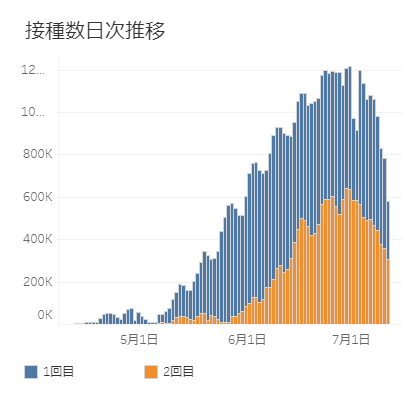Daily vaccination statistics published by the Cabinet Office of the Japanese prime Minister suffer from lag problem: They are not reported back to a central database the day the vaccinations take place. This has the curious effect of making the published chart of daily first and second shots always trend downwards for the most recent 7-120 days or so.

There is a relatively simple way to compensate for the under-count: Its ratio is consistent between first and second doses. In Japan first and second doses for Pfizer are almost religiously spaced 21 days apart. Thus by looking at the first dose count 21 days earlier one can get a close approximation of the real second dose count for a given date. The ratio between the published incomplete second dose number and the approximation derived from the more accurate first dose count can then be applied to the 1st dose Pfizer count for the date you’re looking at. Those two numbers plus the Moderna numbers (which are not subject to the same delays because of the way the SDF sites — the main consumers of Moderna doses — are operating) then give you the real up-to-date General Vaccination count 🙂
From the current numbers we can see that first doses peaked on June 8 at around 650,000 doses day. However, second doses were still steeply climbing then and the total of first second doses exceeded 1,000,000 doses a day on June 15. On June 29, exactly 21 days after the first dose peak, second doses peaked at about 625,000 doses. For about 5 days, second doses clearly outnumbered first doses (June 28-July 2).
After July 3, first doses pulled ahead again, as many municipalities had sent vaccination tickets to people with medical conditions or younger then 65 years. The overall total seems to have largely stabilised at 1.1-1.2 million doses a day.
During July, August and September, the government will distribute a basic allocation of 8,000 boxes (9.36 million doses) every two weeks plus an “adjustment” of 2,000 boxes (2.34 million doses) that will go to municipalities with the best progress in using their allocated doses. This is pushing municipalities to update data on VRS more quickly, as this will be the metric used by the government to allocate the “adjustment” doses. The basic allocation is based on the number of residents age 12-64 in each municipality (the amounts for age 65 and above have already been fully distributed).
One potential problem with this is the fact that some local clinics have been vaccinating people who did not have a vaccination ticket with bar code yet, making this portion of the vaccination total hard to track. The doses have been allocated to the municipalities but may appear unused in VRS.
